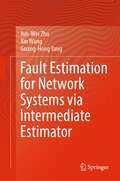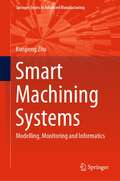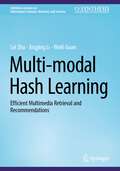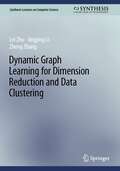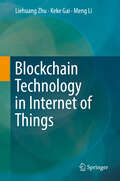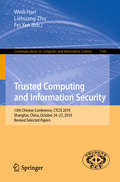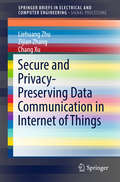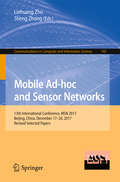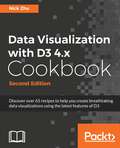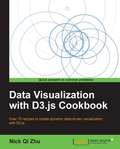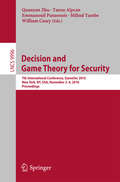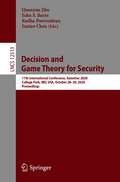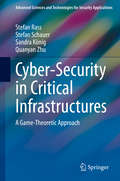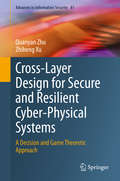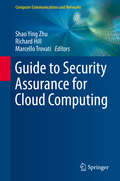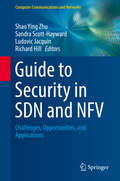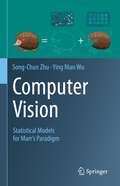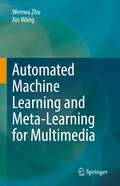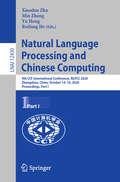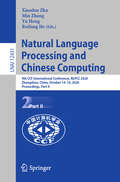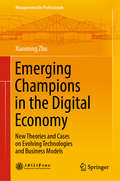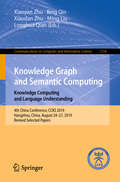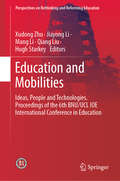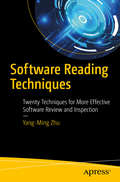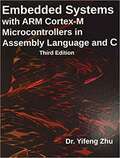- Table View
- List View
Fault Estimation for Network Systems via Intermediate Estimator
by Jun-Wei Zhu Xin Wang Guang-Hong YangThis book is concerned with the fault estimation problem for network systems. Firstly, to improve the existing adaptive fault estimation observer, a novel so-called intermediate estimator is proposed to identify the actuator or sensor faults in dynamic control systems with high accuracy and convergence speed. On this basis, by exploiting the properties of network systems such as multi-agent systems and large-scale interconnected systems, this book introduces the concept of distributed intermediate estimator; faults in different nodes can be estimated simultaneously; meanwhile, satisfactory consensus performances can be obtained via compensation based protocols. Finally, the characteristics of the new fault estimation methodology are verified and discussed by a series of experimental results on networked multi-axis motion control systems. This book can be used as a reference book for researcher and designer in the field of fault diagnosis and fault-tolerant control and can also be used as a reference book for senior undergraduate and graduate students in colleges and universities.
Smart Machining Systems: Modelling, Monitoring and Informatics (Springer Series in Advanced Manufacturing)
by Kunpeng ZhuThis book provides the tools to enhance the precision, automation and intelligence of modern CNC machining systems. Based on a detailed description of the technical foundations of the machining monitoring system, it develops the general idea of design and implementation of smart machining monitoring systems, focusing on the tool condition monitoring system. The book is structured in two parts. Part I discusses the fundamentals of machining systems, including modeling of machining processes, mathematical basics of condition monitoring and the framework of TCM from a machine learning perspective. Part II is then focused on the applications of these theories. It explains sensory signal processing and feature extraction, as well as the cyber-physical system of the smart machining system. Its utilisation of numerous illustrations and diagrams explain the ideas presented in a clear way, making this book a valuable reference for researchers, graduate students and engineers alike.
Multi-modal Hash Learning: Efficient Multimedia Retrieval and Recommendations (Synthesis Lectures on Information Concepts, Retrieval, and Services)
by Lei Zhu Jingjing Li Weili GuanThis book systemically presents key concepts of multi-modal hashing technology, recent advances on large-scale efficient multimedia search and recommendation, and recent achievements in multimedia indexing technology. With the explosive growth of multimedia contents, multimedia retrieval is currently facing unprecedented challenges in both storage cost and retrieval speed. The multi-modal hashing technique can project high-dimensional data into compact binary hash codes. With it, the most time-consuming semantic similarity computation during the multimedia retrieval process can be significantly accelerated with fast Hamming distance computation, and meanwhile the storage cost can be reduced greatly by the binary embedding. The authors introduce the categorization of existing multi-modal hashing methods according to various metrics and datasets. The authors also collect recent multi-modal hashing techniques and describe the motivation, objective formulations, and optimization steps for context-aware hashing methods based on the tag-semantics transfer.
Dynamic Graph Learning for Dimension Reduction and Data Clustering (Synthesis Lectures on Computer Science)
by Lei Zhu Jingjing Li Zheng ZhangThis book illustrates how to achieve effective dimension reduction and data clustering. The authors explain how to accomplish this by utilizing the advanced dynamic graph learning technique in the era of big data. The book begins by providing background on dynamic graph learning. The authors discuss why it has attracted considerable research attention in recent years and has become well recognized as an advanced technique. After covering the key topics related to dynamic graph learning, the book discusses the recent advancements in the area. The authors then explain how these techniques can be practically applied for several purposes, including feature selection, feature projection, and data clustering.
Blockchain Technology in Internet of Things
by Liehuang Zhu Keke Gai Meng LiThis book focuses on picturing B-IoT techniques from a few perspectives, which are architecture, key technologies, security and privacy, service models and framework, practical use cases and more. Main contents of this book derive from most updated technical achievements or breakthroughs in the field. A number of representative IoT service offerings will be covered by this book, such as vehicular networks, document sharing system, and telehealth. Both theoretical and practical contents will be involved in this book in order to assist readers to have a comprehensive and deep understanding the mechanism of using blockchain for powering up IoT systems. The blockchain-enabled Internet of Things (B-IoT) is deemed to be a novel technical alternative that provides network-based services with additional functionalities, benefits, and implementations in terms of decentralization, immutability, and auditability. Towards the enhanced secure and privacy-preserving Internet of Things (IoT), this book introduces a few significant aspects of B-IoT, which includes fundamental knowledge of both blockchain and IoT, state-of-the-art reviews of B-IoT applications, crucial components in the B-IoT system and the model design, and future development potentials and trends.IoT technologies and services, e.g. cloud data storage technologies and vehicular services, play important roles in wireless technology developments. On the other side, blockchain technologies are being adopted in a variety of academic societies and professional realms due to its promising characteristics. It is observable that the research and development on integrating these two technologies will provide critical thinking and solid references for contemporary and future network-relevant solutions. This book targets researchers and advanced level students in computer science, who are focused on cryptography, cloud computing and internet of things, as well as electrical engineering students and researchers focused on vehicular networks and more. Professionals working in these fields will also find this book to be a valuable resource.
Trusted Computing and Information Security: 13th Chinese Conference, CTCIS 2019, Shanghai, China, October 24–27, 2019, Revised Selected Papers (Communications in Computer and Information Science #1149)
by Liehuang Zhu Fei Yan Weili HanThis book constitutes the refereed proceedings of the Chinese Conference on Trusted Computing and Information Security, CTCIS 2019, held in Shanghai, China, in October 2019.The 22 revised full papers presented were carefully reviewed and selected from 247 submissions. The papers are centered around cryptography, systems security, trusted computing, information security, network security, information hiding.
Secure and Privacy-Preserving Data Communication in Internet of Things
by Liehuang Zhu Zijian Zhang Chang XuThis book mainly concentrates on protecting data security and privacy when participants communicate with each other in the Internet of Things (IoT). Technically, this book categorizes and introduces a collection of secure and privacy-preserving data communication schemes/protocols in three traditional scenarios of IoT: wireless sensor networks, smart grid and vehicular ad-hoc networks recently. This book presents three advantages which will appeal to readers. Firstly, it broadens reader's horizon in IoT by touching on three interesting and complementary topics: data aggregation, privacy protection, and key agreement and management. Secondly, various cryptographic schemes/protocols used to protect data confidentiality and integrity is presented. Finally, this book will illustrate how to design practical systems to implement the algorithms in the context of IoT communication. In summary, readers can simply learn and directly apply the new technologies to communicate data in IoT after reading this book.
Mobile Ad-hoc and Sensor Networks: 13th International Conference, Msn 2017, Beijing, China, December 17-20, 2017, Revised Selected Papers (Communications In Computer And Information Science #747)
by Liehuang Zhu Sheng ZhongThis book constitutes the refereed proceedings of the 13th International Conference on Mobile Ad-hoc and Sensor Networks, MSN 2017, held in Beijing, China, in December 2017. The 39 revised full papers presented were carefully reviewed and selected from 145 submissions. The papers address issues such as multi-hop wireless networks and wireless mesh networks; sensor and actuator networks; vehicle ad hoc networks; mobile social network; delay tolerant networks and opportunistic networking; cyber-physical systems; internet of things; system modeling and performance analysis; routing and network protocols; data transport and management in mobile networks; resource management and wireless QoS provisioning; security and privacy; cross layer design and optimization; novel applications and architectures.
Data Visualization with D3 4.x Cookbook - Second Edition
by Nick Qi ZhuIf you are a developer familiar with HTML, CSS, and JavaScript, and you wish to get the most out of D3, then this book is for you. This book can also serve as a desktop quick-reference guide for experienced data visualization developers. You’ll also find this book useful if you’re a D3 user who wants to take advantage of the new features introduced in D3 4.0. You need previous experience of D3.
Data Visualization with D3.js Cookbook
by Nick Qi ZhuPacked with practical recipes, this is a step-by-step guide to learning data visualization with D3 with the help of detailed illustrations and code samples.If you are a developer familiar with HTML, CSS, and JavaScript, and you wish to get the most out of D3, then this book is for you. This book can also serve as a desktop quick-reference guide for experienced data visualization developers.
Decision and Game Theory for Security
by Quanyan Zhu Tansu Alpcan Emmanouil Panaousis Milind Tambe William CaseyThis book constitutes the refereed proceedings of the 6th International Conference on Decision and Game Theory for Security, GameSec 2015, held in London, UK, in November 2015. The 16 revised full papers presented together with 5 short papers were carefully reviewed and selected from 37 submissions. Game and decision theory has emerged as a valuable systematic framework with powerful analytical tools in dealing with the intricacies involved in making sound and sensible security decisions. For instance, game theory provides methodical approaches to account for interdependencies of security decisions, the role of hidden and asymmetric information, the perception of risks and costs in human behaviour, the incentives/limitations of the attackers, and much more. Combined with our classical approach to computer and network security, and drawing from various fields such as economic, social and behavioural sciences, game and decision theory is playing a fundamental role in the development of the pillars of the "science of security".
Decision and Game Theory for Security: 11th International Conference, GameSec 2020, College Park, MD, USA, October 28–30, 2020, Proceedings (Lecture Notes in Computer Science #12513)
by Quanyan Zhu John S. Baras Radha Poovendran Juntao ChenThis book constitutes the refereed proceedings of the 11th International Conference on Decision and Game Theory for Security, GameSec 2020,held in College Park, MD, USA, in October 2020. Due to COVID-19 pandemic the conference was held virtually The 21 full papers presented together with 2 short papers were carefully reviewed and selected from 29 submissions. The papers focus on machine learning and security; cyber deception; cyber-physical systems security; security of network systems; theoretic foundations of security games; emerging topics.
Cyber-Security in Critical Infrastructures: A Game-Theoretic Approach (Advanced Sciences and Technologies for Security Applications)
by Quanyan Zhu Stefan Rass Stefan Schauer Sandra KönigThis book presents a compendium of selected game- and decision-theoretic models to achieve and assess the security of critical infrastructures. Given contemporary reports on security incidents of various kinds, we can see a paradigm shift to attacks of an increasingly heterogeneous nature, combining different techniques into what we know as an advanced persistent threat. Security precautions must match these diverse threat patterns in an equally diverse manner; in response, this book provides a wealth of techniques for protection and mitigation. Much traditional security research has a narrow focus on specific attack scenarios or applications, and strives to make an attack “practically impossible.” A more recent approach to security views it as a scenario in which the cost of an attack exceeds the potential reward. This does not rule out the possibility of an attack but minimizes its likelihood to the least possible risk. The book follows this economic definition of security, offering a management scientific view that seeks a balance between security investments and their resulting benefits. It focuses on optimization of resources in light of threats such as terrorism and advanced persistent threats. Drawing on the authors’ experience and inspired by real case studies, the book provides a systematic approach to critical infrastructure security and resilience. Presenting a mixture of theoretical work and practical success stories, the book is chiefly intended for students and practitioners seeking an introduction to game- and decision-theoretic techniques for security. The required mathematical concepts are self-contained, rigorously introduced, and illustrated by case studies. The book also provides software tools that help guide readers in the practical use of the scientific models and computational frameworks.
Cross-Layer Design for Secure and Resilient Cyber-Physical Systems: A Decision and Game Theoretic Approach (Advances in Information Security #81)
by Quanyan Zhu Zhiheng XuThis book introduces a cross-layer design to achieve security and resilience for CPSs (Cyber-Physical Systems). The authors interconnect various technical tools and methods to capture the different properties between cyber and physical layers. Part II of this book bridges the gap between cryptography and control-theoretic tools. It develops a bespoke crypto-control framework to address security and resiliency in control and estimation problems where the outsourcing of computations is possible. Part III of this book bridges the gap between game theory and control theory and develops interdependent impact-aware security defense strategies and cyber-aware resilient control strategies.With the rapid development of smart cities, there is a growing need to integrate the physical systems, ranging from large-scale infrastructures to small embedded systems, with networked communications. The integration of the physical and cyber systems forms Cyber-Physical Systems (CPSs), enabling the use of digital information and control technologies to improve the monitoring, operation, and planning of the systems. Despite these advantages, they are vulnerable to cyber-physical attacks, which aim to damage the physical layer through the cyber network.This book also uses case studies from autonomous systems, communication-based train control systems, cyber manufacturing, and robotic systems to illustrate the proposed methodologies. These case studies aim to motivate readers to adopt a cross-layer system perspective toward security and resilience issues of large and complex systems and develop domain-specific solutions to address CPS challenges.A comprehensive suite of solutions to a broad range of technical challenges in secure and resilient control systems are described in this book (many of the findings in this book are useful to anyone working in cybersecurity). Researchers, professors, and advanced-level students working in computer science and engineering will find this book useful as a reference or secondary text. Industry professionals and military workers interested in cybersecurity will also want to purchase this book.
Guide to Security Assurance for Cloud Computing
by Shao Ying Zhu Richard Hill Marcello TrovatiThis practical and didactic text/reference discusses the leading edge of secure cloud computing, exploring the essential concepts and principles, tools, techniques and deployment models in this field. Enlightening perspectives are presented by an international collection of pre-eminent authorities in cloud security assurance from both academia and industry. Topics and features: · Describes the important general concepts and principles of security assurance in cloud-based environments · Presents applications and approaches to cloud security that illustrate the current state of the art · Reviews pertinent issues in relation to challenges that prevent organizations moving to cloud architectures · Provides relevant theoretical frameworks and the latest empirical research findings · Discusses real-world vulnerabilities of cloud-based software in order to address the challenges of securing distributed software · Highlights the practicalities of cloud security, and how applications can assure and comply with legislation · Includes review questions at the end of each chapter This Guide to Security Assurance for Cloud Computing will be of great benefit to a broad audience covering enterprise architects, business analysts and leaders, IT infrastructure managers, cloud security engineers and consultants, and application developers involved in system design and implementation. The work is also suitable as a textbook for university instructors, with the outline for a possible course structure suggested in the preface. The editors are all members of the Computing and Mathematics Department at the University of Derby, UK, where Dr. Shao Ying Zhu serves as a Senior Lecturer in Computing, Dr. Richard Hill as a Professor and Head of the Computing and Mathematics Department, and Dr. Marcello Trovati as a Senior Lecturer in Mathematics. The other publications of the editors include the Springer titles Big-Data Analytics and Cloud Computing, Guide to Cloud Computing and Cloud Computing for Enterprise Architectures.
Guide to Security in SDN and NFV
by Shao Ying Zhu Sandra Scott-Hayward Ludovic Jacquin Richard HillThis book highlights the importance of security in the design, development and deployment of systems based on Software-Defined Networking (SDN) and Network Functions Virtualization (NFV), together referred to as SDNFV. Presenting a comprehensive guide to the application of security mechanisms in the context of SDNFV, the content spans fundamental theory, practical solutions, and potential applications in future networks. Topics and features: introduces the key security challenges of SDN, NFV and Cloud Computing, providing a detailed tutorial on NFV security; discusses the issue of trust in SDN/NFV environments, covering roots of trust services, and proposing a technique to evaluate trust by exploiting remote attestation; reviews a range of specific SDNFV security solutions, including a DDoS detection and remediation framework, and a security policy transition framework for SDN; describes the implementation of a virtual home gateway, and a project that combines dynamic security monitoring with big-data analytics to detect network-wide threats; examines the security implications of SDNFV in evolving and future networks, from network-based threats to Industry 4. 0 machines, to the security requirements for 5G; investigates security in the Observe, Orient, Decide and Act (OODA) paradigm, and proposes a monitoring solution for a Named Data Networking (NDN) architecture; includes review questions in each chapter, to test the reader's understanding of each of the key concepts described. This informative and practical volume is an essential resource for researchers interested in the potential of SDNFV systems to address a broad range of network security challenges. The work will also be of great benefit to practitioners wishing to design secure next-generation communication networks, or to develop new security-related mechanisms for SDNFV systems.
Computer Vision: Statistical Models for Marr's Paradigm
by Song-Chun Zhu Ying Nian WuAs the first book of a three-part series, this book is offered as a tribute to pioneers in vision, such as Béla Julesz, David Marr, King-Sun Fu, Ulf Grenander, and David Mumford. The authors hope to provide foundation and, perhaps more importantly, further inspiration for continued research in vision. This book covers David Marr's paradigm and various underlying statistical models for vision. The mathematical framework herein integrates three regimes of models (low-, mid-, and high-entropy regimes) and provides foundation for research in visual coding, recognition, and cognition. Concepts are first explained for understanding and then supported by findings in psychology and neuroscience, after which they are established by statistical models and associated learning and inference algorithms. A reader will gain a unified, cross-disciplinary view of research in vision and will accrue knowledge spanning from psychology to neuroscience to statistics.
Automated Machine Learning and Meta-Learning for Multimedia
by Wenwu Zhu Xin WangThis book disseminates and promotes the recent research progress and frontier development on AutoML and meta-learning as well as their applications on computer vision, natural language processing, multimedia and data mining related fields. These are exciting and fast-growing research directions in the general field of machine learning. The authors advocate novel, high-quality research findings, and innovative solutions to the challenging problems in AutoML and meta-learning. This topic is at the core of the scope of artificial intelligence, and is attractive to audience from both academia and industry.This book is highly accessible to the whole machine learning community, including: researchers, students and practitioners who are interested in AutoML, meta-learning, and their applications in multimedia, computer vision, natural language processing and data mining related tasks. The book is self-contained and designed for introductory and intermediate audiences. No special prerequisite knowledge is required to read this book.
Natural Language Processing and Chinese Computing: 9th CCF International Conference, NLPCC 2020, Zhengzhou, China, October 14–18, 2020, Proceedings, Part I (Lecture Notes in Computer Science #12430)
by Xiaodan Zhu Min Zhang Yu Hong Ruifang HeThis two-volume set of LNAI 12340 and LNAI 12341 constitutes the refereed proceedings of the 9th CCF Conference on Natural Language Processing and Chinese Computing, NLPCC 2020, held in Zhengzhou, China, in October 2020.The 70 full papers, 30 poster papers and 14 workshop papers presented were carefully reviewed and selected from 320 submissions. They are organized in the following areas: Conversational Bot/QA; Fundamentals of NLP; Knowledge Base, Graphs and Semantic Web; Machine Learning for NLP; Machine Translation and Multilinguality; NLP Applications; Social Media and Network; Text Mining; and Trending Topics.
Natural Language Processing and Chinese Computing: 9th CCF International Conference, NLPCC 2020, Zhengzhou, China, October 14–18, 2020, Proceedings, Part II (Lecture Notes in Computer Science #12431)
by Xiaodan Zhu Min Zhang Yu Hong Ruifang HeThis two-volume set of LNAI 12340 and LNAI 12341 constitutes the refereed proceedings of the 9th CCF Conference on Natural Language Processing and Chinese Computing, NLPCC 2020, held in Zhengzhou, China, in October 2020.The 70 full papers, 30 poster papers and 14 workshop papers presented were carefully reviewed and selected from 320 submissions. They are organized in the following areas: Conversational Bot/QA; Fundamentals of NLP; Knowledge Base, Graphs and Semantic Web; Machine Learning for NLP; Machine Translation and Multilinguality; NLP Applications; Social Media and Network; Text Mining; and Trending Topics.
Emerging Champions in the Digital Economy: New Theories and Cases on Evolving Technologies and Business Models (Management for Professionals)
by Xiaoming ZhuThis book presents a list of emerging and established companies which have a strong belief in the digital economy and elaborate their unique digital innovations. The companies selected for this book are from a variety of industries, including both Chinese and international leading technology companies such as iflytek, JD.com, IBM and Amazon. A wide range of commercial fields are covered ensuring a comprehensive research on the topic of digital economy, for example Shanghai Center (Construction Management), PPDai(Finance), 3Dmed(Precision Medicine), Children’s Hospital of Shanghai(Medical Service), First Respond (First Aid Service) etc. All cases are presented based on field studies as well as in-depth interviews and are followed by thought-provoking case analysis, which can help readers to better understand the cases from different perspectives. Readers can use this book as a good reference to address challenges and capture opportunities in the context of ever growing digital economy.
Knowledge Graph and Semantic Computing: 4th China Conference, CCKS 2019, Hangzhou, China, August 24–27, 2019, Revised Selected Papers (Communications in Computer and Information Science #1134)
by Xiaoyan Zhu Ming Liu Bing Qin Xiaodan Zhu Longhua QianThis book constitutes the refereed proceedings of the 4th China Conference on Knowledge Graph and Semantic Computing, CCKS 2019, held in Hangzhou, China, in August 2019. The 18 revised full papers presented were carefully reviewed and selected from 140 submissions. The papers cover wide research fields including the knowledge graph, the semantic Web, linked data, NLP, information extraction, knowledge representation and reasoning.
Education and Mobilities: Ideas, People and Technologies. Proceedings of the 6th BNU/UCL IOE International Conference in Education (Perspectives on Rethinking and Reforming Education)
by Xudong Zhu Mang Li Qiang Liu Hugh Starkey Jiayong LiThis book gathers selected original papers presented at the Sixth Beijing Normal University - University College London, Institute of Education International Conference in Education, a biennial event organised in partnership between this two universities. Readers will find a wealth of papers and reports on research involving schools and the initial and professional development of teachers, revealing links between research, policy and practice, while also analyzing key themes in education, including public goals and policies, pedagogy, curricula, organisation, resources and technologies, and institutional effectiveness. An essential guide for anyone who wishes to understand the main issues involved in mobilities of ideas, people and technology in the field of education, the book offers an extensive introduction, and can also be used as a resource for empirical and conceptual research into related issues.
Software Reading Techniques
by Yang‐ming ZhuLearn twenty software reading techniques to enhance your effectiveness in reviewing and inspecting software artifacts such as requirements specifications, designs, code files, and usability. Software review and inspection is the best practice in software development that detects and fixes problems early. Software professionals are trained to write software but not read and analyze software written by peers. As a result, individual reading skills vary widely. Because the effectiveness of software review and inspection is highly dependent on individual reading skills, differential outcomes among software readers vary by a factor of ten. Software Reading Techniques is designed to close that gap. Dr Yang‐Ming Zhu's depth of experience as a software architect, team leader, and scientist make him singularly well-equipped to bring you up to speed on all the techniques and tips for optimizing the effectiveness and efficiency of your software review and inspection skills. What You'll Learn: Improve software review, inspection procedures, and reading skills Study traditional and modern advanced reading techniques applicable to software artifacts Master specific reading techniques for software requirements specification, software design, and code Who This Book Is For: Software professionals and software engineering students and researchers
Embedded Systems With Arm (register Mark) Cortex-m Microcontrollers In Assembly Language And C
by Yifeng ZhuSignificant changes in the third edition include updated serial communication description (UART, SPI, and I2C), new serial communication examples, incorporation of GNU gcc compiler, low power modes, modification of example programs from STM32L1 (Cortex-M3) to STM32L4 (Cortex-M4). The book introduces basic programming of ARM Cortex-M cores in assembly and C at the register level, and the fundamentals of embedded system design. It presents basic concepts such as data representations (integer, fixed-point, floating-point), assembly instructions, stack, and implementing basic controls and functions of C language at the assembly level. It covers advanced topics such as interrupts, mixing C and assembly, direct memory access (DMA), system timers (SysTick), multi-tasking, SIMD instructions for digital signal processing (DSP), and instruction encoding/decoding. The book also gives detailed examples of interfacing peripherals, such as general purpose I/O (GPIO), LCD driver, keypad interaction, stepper motor control, PWM output, timer input capture, DAC, ADC, real-time clock (RTC), and serial communication (USART, I2C, SPI, and USB).
